Aging Mechanism and Properties of SBS Modified Bitumen under Complex Environmental Conditions
Abstract
1. Introduction
2. Materials and Methodology
2.1. Materials
2.2. Preparation of SBS Modified Bitumen
2.3. Preparation of Water, Acid and Salt Solutions
2.4. Aging Procedure
2.5. Physical Properties Test
2.6. Dynamic Shear Rheometer (DSR)
2.7. Fourier Transform Infrared Spectroscopy (FTIR)
2.8. Scanning Electron Microscope (SEM)
3. Results and Discussion
3.1. Physical Property
3.2. Rheological Properties
3.3. Four-Component Analysis
3.4. Functional Group Characteristics
3.5. Apparent Morphology
4. Summary and Conclusions
Author Contributions
Funding
Conflicts of Interest
References
- Liu, G.; Nielsen, E.; Komacka, J.; Greet, L.; Ven, M.v.d. Rheological and chemical evaluation on the ageing properties of SBS polymer modified bitumen: From the laboratory to the field. Constr. Build. Mater. 2014, 51, 244–248. [Google Scholar] [CrossRef]
- Zhao, X.; Wang, S.; Wang, Q.; Yao, H. Rheological and structural evolution of SBS modified asphalts under natural weathering. Fuel 2016, 184, 242–247. [Google Scholar] [CrossRef]
- Lv, S.; Liu, C.; Chen, D.; Zheng, J.; You, Z.; You, L. Normalization of fatigue characteristics for asphalt mixtures under different stress states. Constr. Build. Mater. 2018, 177, 33–42. [Google Scholar] [CrossRef]
- Jin, J.; Tan, Y.; Liu, R.; Zheng, J.; Zhang, J. Synergy effect of attapulgite, rubber, diatomite on the properties of organic montmorillonite modified asphalt. J. Mater. Civ. Eng. 2019, 32, 04018388. [Google Scholar] [CrossRef]
- Li, J.; Zhang, J.; Qian, G.; Zheng, J.; Zhang, Y. Three-dimensional simulation of aggregate and asphalt mixture using parameterized shape and size gradation. J. Mater. Civ. Eng. 2019, 31, 04019004. [Google Scholar] [CrossRef]
- Lins, V.F.C.; Araújo, M.F.A.S.; Yoshida, M.I.; Ferraz, V.P.; Andrada, D.M.; Lameiras, F.S. Photodegradation of hot-mix asphalt. Fuel 2008, 87, 3254–3261. [Google Scholar] [CrossRef]
- Zhang, H.; Chen, Z.; Xu, G.; Shi, C. Evaluation of aging behaviors of asphalt binders through different rheological indices. Fuel 2018, 221, 78–88. [Google Scholar] [CrossRef]
- Lv, S.; Xia, C.; Liu, C.; Zheng, J.; Zhang, F. Fatigue equation for asphalt mixture under low temperature and low loading frequency conditions. Constr. Build. Mater. 2019, 211, 1085–1093. [Google Scholar] [CrossRef]
- Cortizo, M.S.; Larsen, D.O.; Bianchetto, H.; Alessandrini, J.L. Effect of the thermal degradation of SBS copolymers during the ageing of modified asphalts. Polym. Degrad. Stabil. 2004, 86, 275–282. [Google Scholar] [CrossRef]
- Shi, C.; Stegemann, J.A. Acid corrosion resistance of different cementing materials. Cement Concrete Res. 2000, 30, 803–808. [Google Scholar] [CrossRef]
- Zivica, V.; Bajza, A. Acidic attack of cement based materials—a review: Part 1. Principle of acidic attack. Constr. Build. Mater. 2001, 15, 331–340. [Google Scholar] [CrossRef]
- Feng, D.; Yi, J.; Wang, D.; Chen, L. Impact of salt and freeze–thaw cycles on performance of asphalt mixtures in coastal frozen region of China. Cold Reg. Sci. Technol. 2010, 62, 34–41. [Google Scholar] [CrossRef]
- Durrieu, F.; Farcas, F.; Mouillet, V. The influence of UV aging of a Styrene/Butadiene/Styrene modified bitumen: Comparison between laboratory and on site aging. Fuel 2007, 86, 1446–1451. [Google Scholar] [CrossRef]
- Zeng, W.; Wu, S.; Wen, J.; Chen, Z. The temperature effects in aging index of asphalt during UV aging process. Constr. Build. Mater. 2015, 93, 1125–1131. [Google Scholar] [CrossRef]
- de Sá Araujo, M.d.F.A.; Lins, V.d.F.C.; Pasa, V.M.D.; Leite, L.F.M. Weathering aging of modified asphalt binders. Fuel Process. Technol. 2013, 115, 19–25. [Google Scholar] [CrossRef]
- Xie, S.; Qi, L.; Zhou, D. Investigation of the effects of acid rain on the deterioration of cement concrete using accelerated tests established in laboratory. Atmos. Environ. 2004, 38, 4457–4466. [Google Scholar] [CrossRef]
- Hill, J.; Byars, E.A.; Sharp, J.H.; Lynsdale, C.J.; Cripps, J.C.; Zhou, Q. An experimental study of combined acid and sulfate attack of concrete. Cement Concrete Compos. 2003, 25, 997–1003. [Google Scholar] [CrossRef]
- Dai, Z.; Shen, J.; Shi, P.; Zhu, H.; Li, X. Nano-sized morphology of asphalt components separated from weathered asphalt binders. Constr. Build. Mater. 2018, 182, 588–596. [Google Scholar] [CrossRef]
- Menapace, I.; Yiming, W.; Masad, E. Chemical analysis of surface and bulk of asphalt binders aged with accelerated weathering tester and standard aging methods. Fuel 2017, 202, 366–379. [Google Scholar] [CrossRef]
- Jin, J.; Tan, Y.; Liu, R.; Lin, F.; Wu, Y.; Qian, G.; Wei, H.; Zheng, J. Structure characteristics of organic bentonite and the effects on rheological and aging properties of asphalt. Powder Technol. 2018, 329, 107–114. [Google Scholar] [CrossRef]
- Liu, X.; Wu, S.; Liu, G.; Li, L.J.M. Effect of Ultraviolet Aging on Rheology and Chemistry of LDH-Modified Bitumen. Materials 2015, 8, 5238–5249. [Google Scholar] [CrossRef]
- Zhang, D.; Zhang, H.; Shi, C. Investigation of aging performance of SBS modified asphalt with various aging methods. Constr. Build. Mater. 2017, 145, 445–451. [Google Scholar] [CrossRef]
- Feng, Z.; Bian, H.; Li, X.; Yu, J. FTIR analysis of UV aging on bitumen and its fractions. Mater. Struct. 2016, 49, 1381–1389. [Google Scholar] [CrossRef]
- Feng, Z.; Yu, J.; Zhang, H.; Kuang, D.; Xue, L. Effect of ultraviolet aging on rheology, chemistry and morphology of ultraviolet absorber modified bitumen. Mater. Struct. 2013, 46, 1123–1132. [Google Scholar] [CrossRef]
- Mouillet, V.; Farcas, F.; Besson, S. Ageing by UV radiation of an elastomer modified bitumen. Fuel 2008, 87, 2408–2419. [Google Scholar] [CrossRef]
- Lu, X.; Isacsson, U. Chemical and rheological evaluation of ageing properties of SBS polymer modified bitumens. Fuel 1998, 77, 961–972. [Google Scholar] [CrossRef]
- Dhalaan, M.A. Characterization and design of recycled asphalt concrete mixtures using indirect tensile test methods. Ph.D. Thesis, University of Texas, Austin, TX, USA, 1982. [Google Scholar]
- Xia, L.; Huanda, G.U.J.E.S. Technology, Study on Effects of Acid Rain on Properties of Foamed Light Soil with River Sludge. Environ. Sci. Technol. 2018, 41, 34–40. [Google Scholar] [CrossRef]
- Zhang, F.; Hu, H.; Wang, L.; Zhou, Q.; Huang, X. Effects of rare earth and acid rain pollution on plant chloroplast ATP synthase and element contents at different growth stages. Chemosphere 2018, 194, 441–449. [Google Scholar] [CrossRef] [PubMed]
- Xu, S.; Yu, J.; Wu, W.; Xue, L.; Sun, Y. Synthesis and characterization of layered double hydroxides intercalated by UV absorbents and their application in improving UV aging resistance of bitumen. Appl. Clay Sci. 2015, 114, 112–119. [Google Scholar] [CrossRef]
- Rasool, R.T.; Hongru, Y.; Hassan, A.; Wang, S.; Zhang, H. In-field aging process of high content SBS modified asphalt in porous pavement. Polym. Degrad. Stabil. 2018, 155, 220–229. [Google Scholar] [CrossRef]
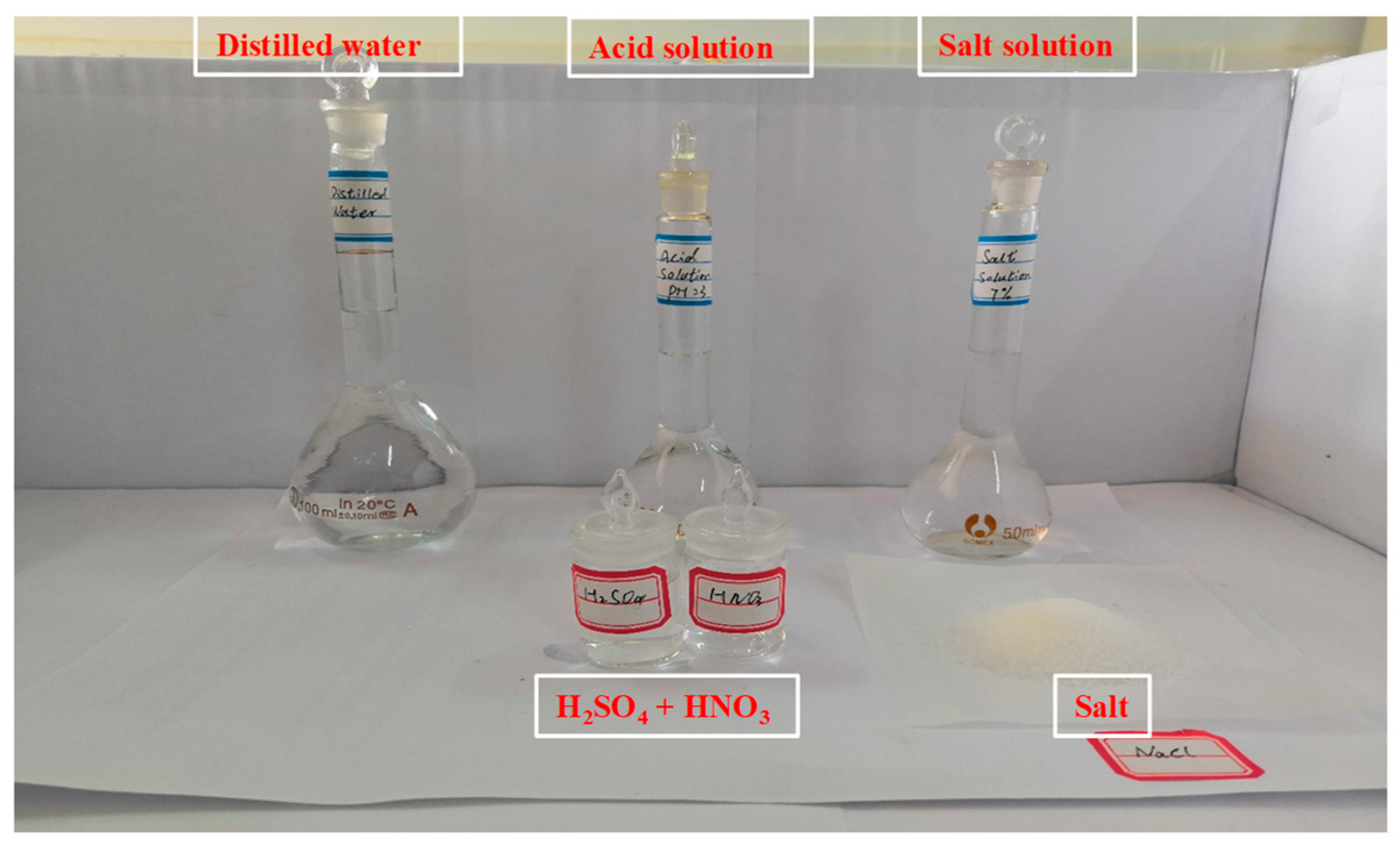
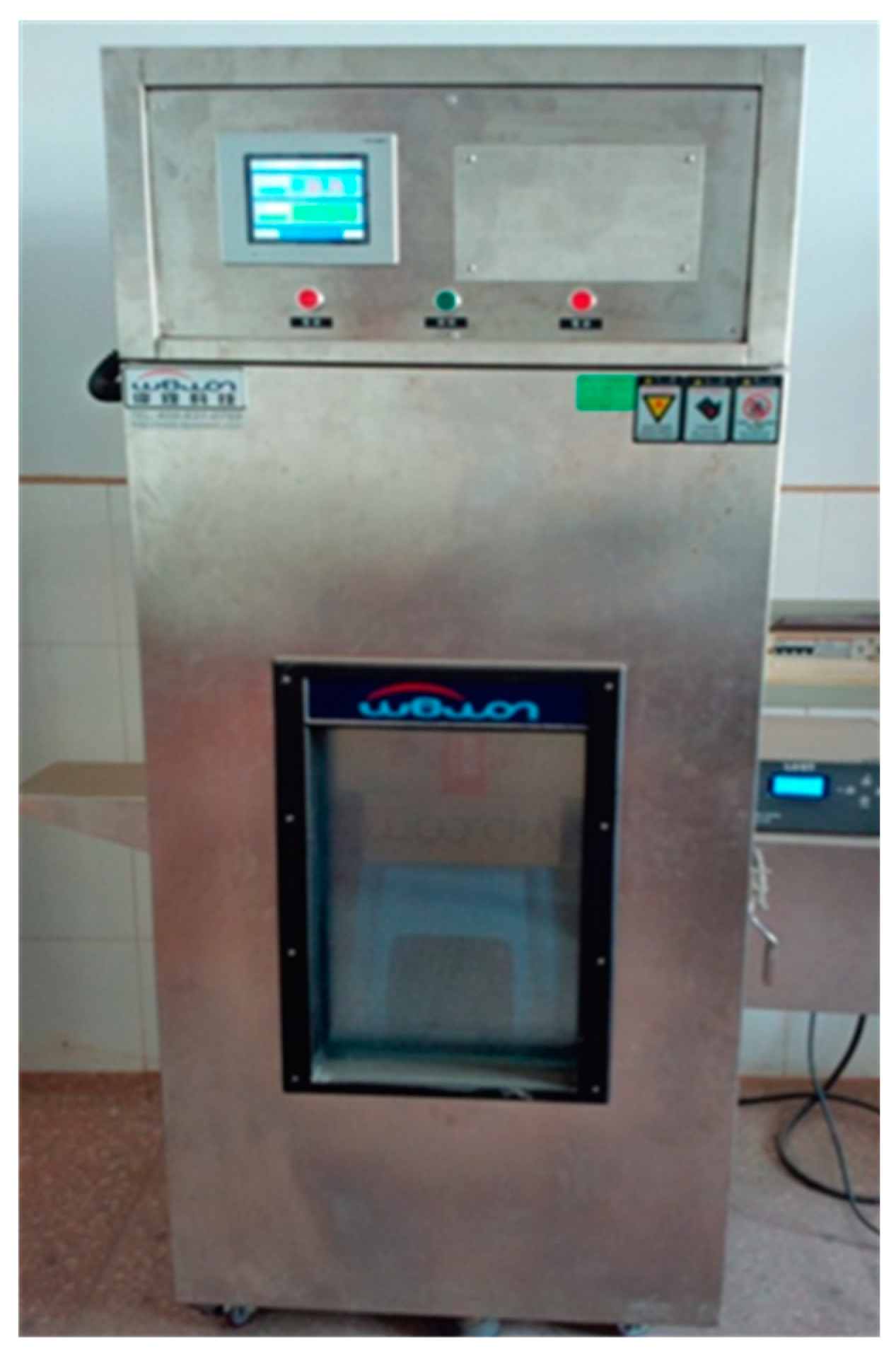
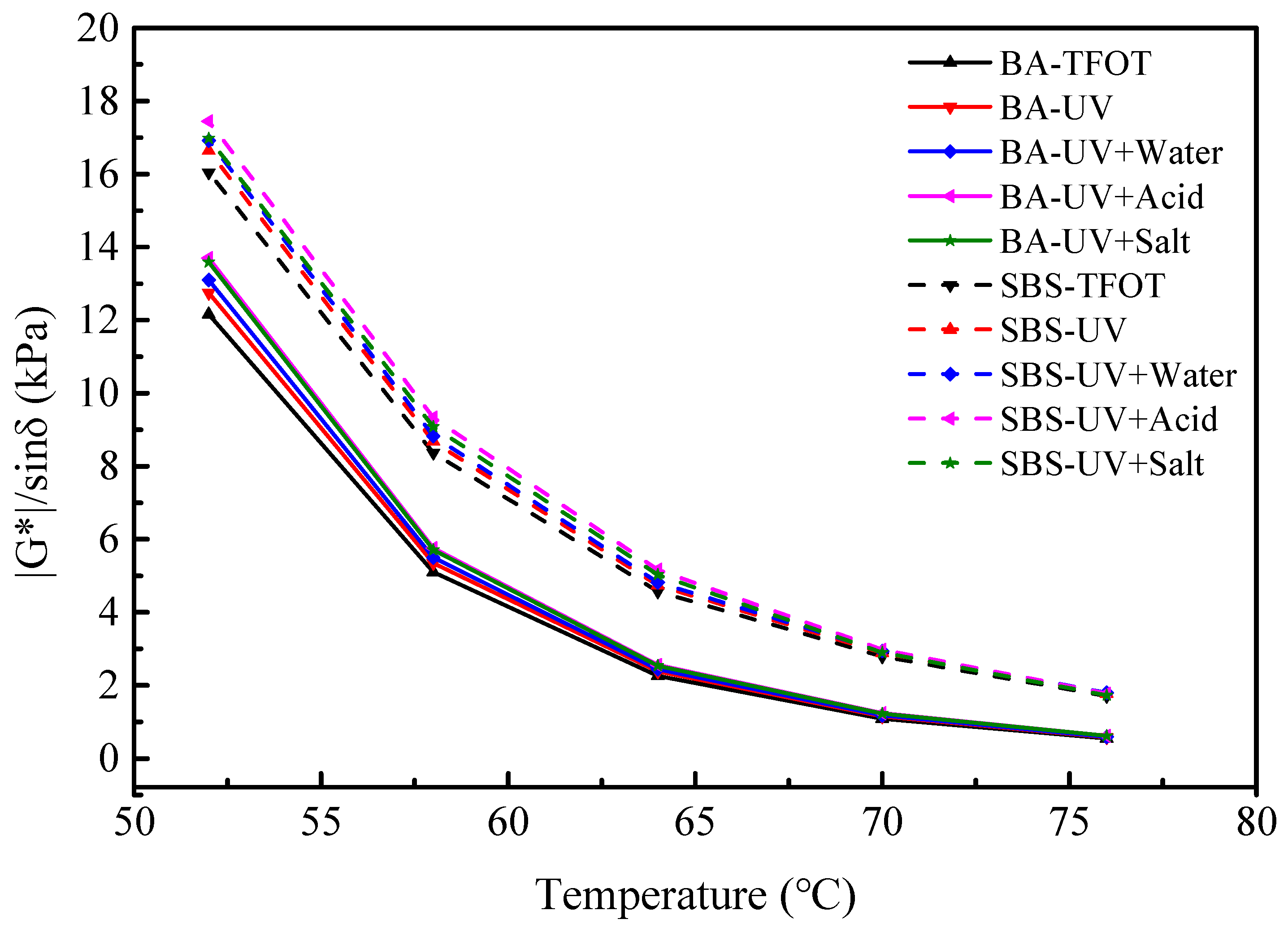
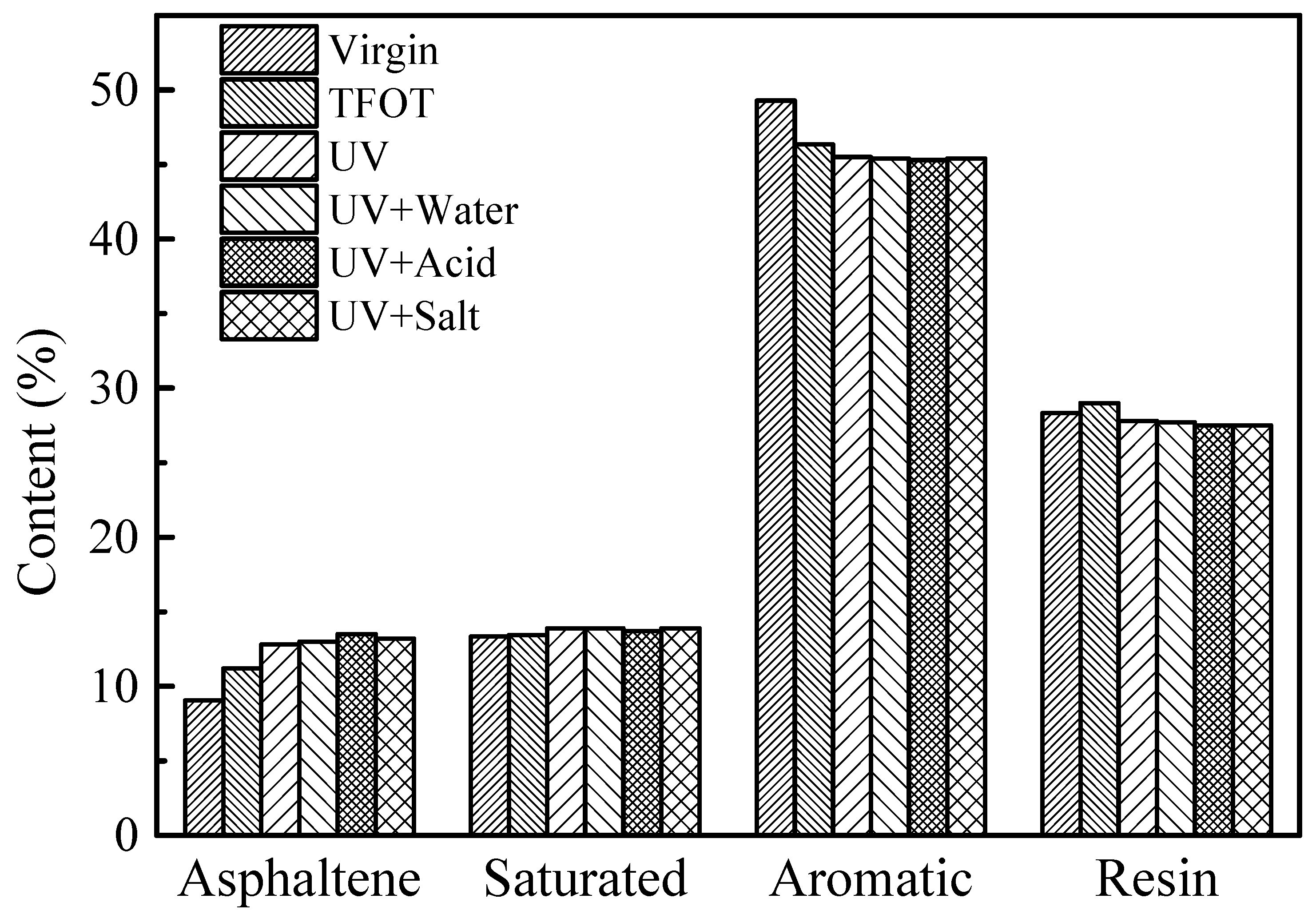
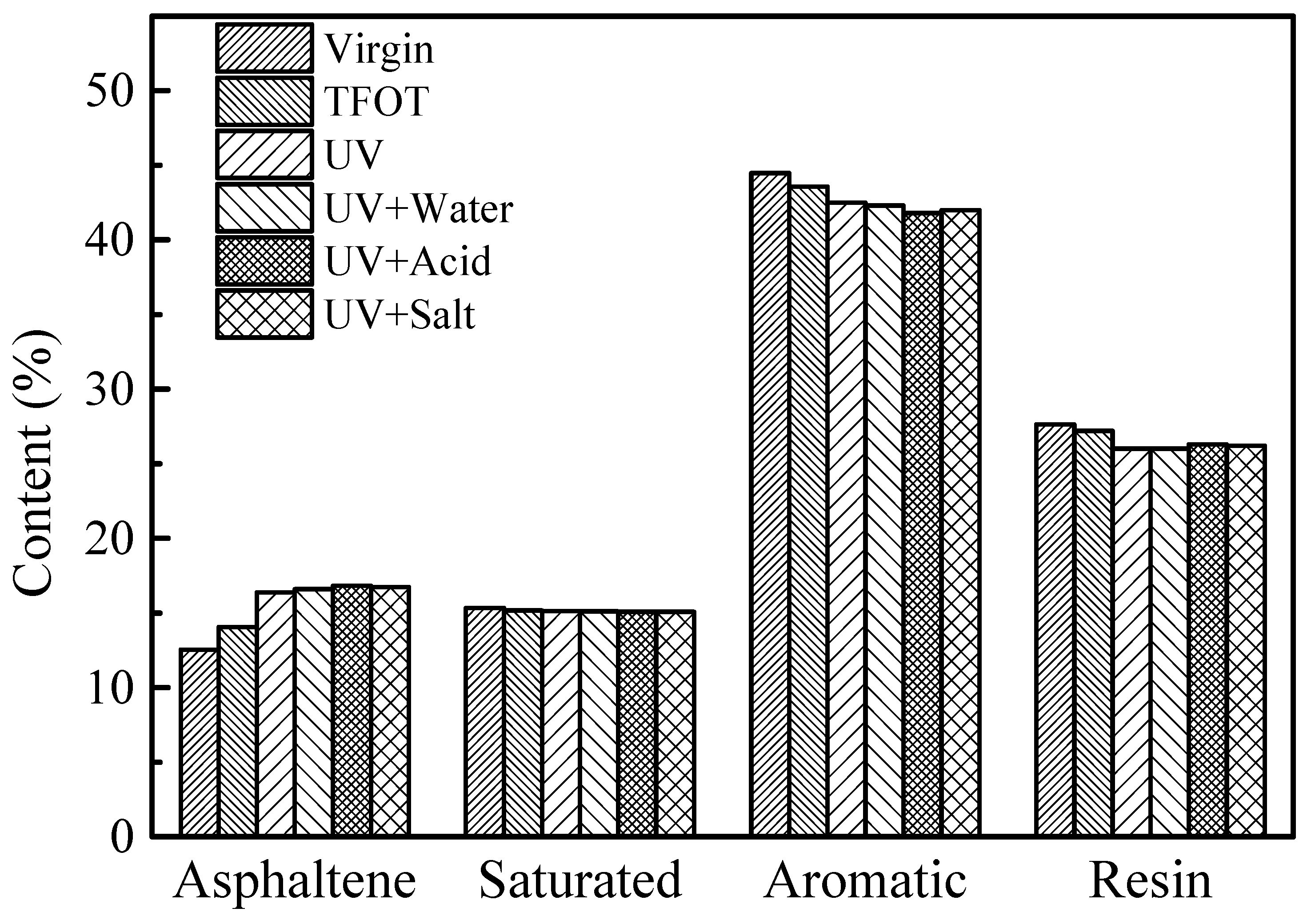
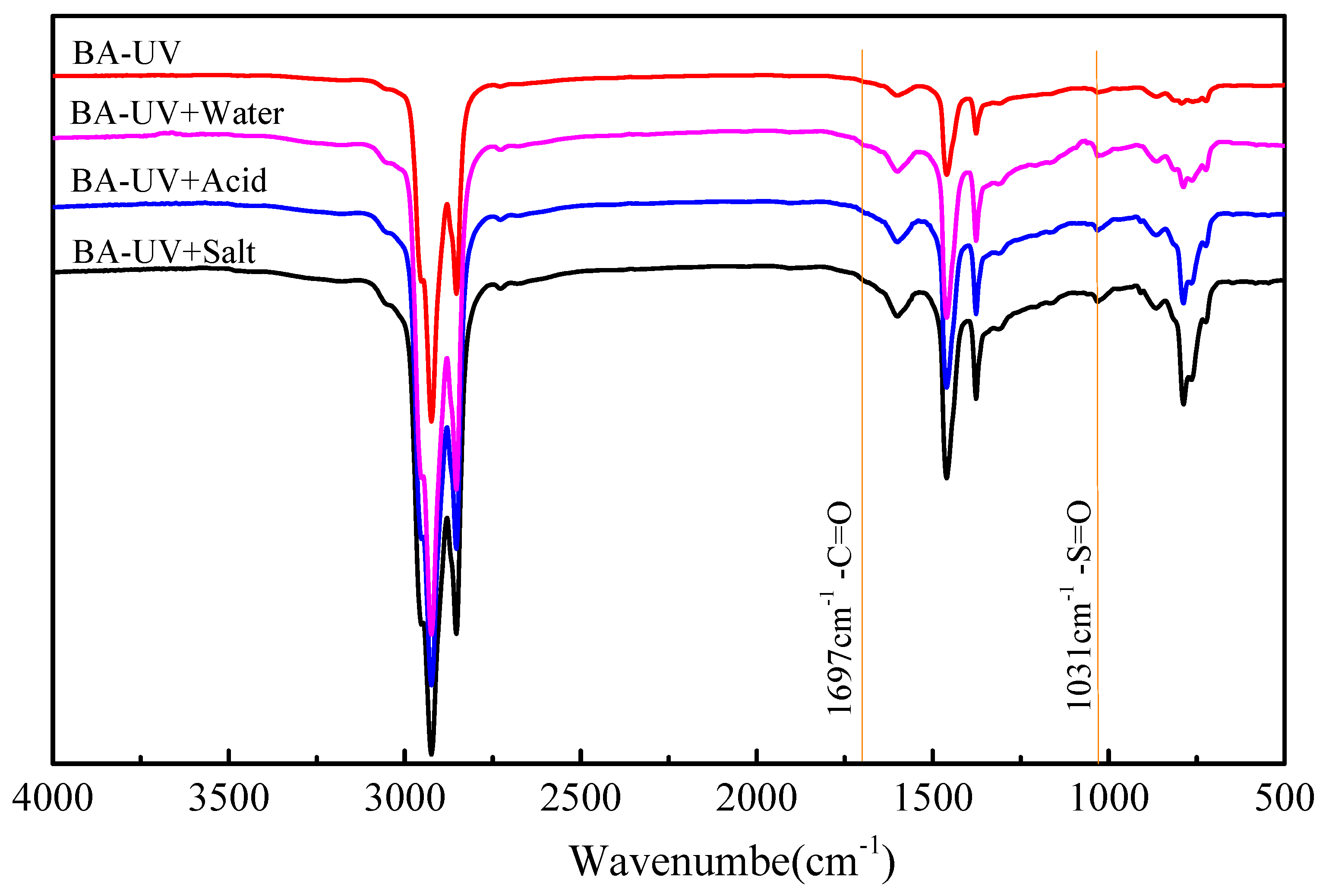
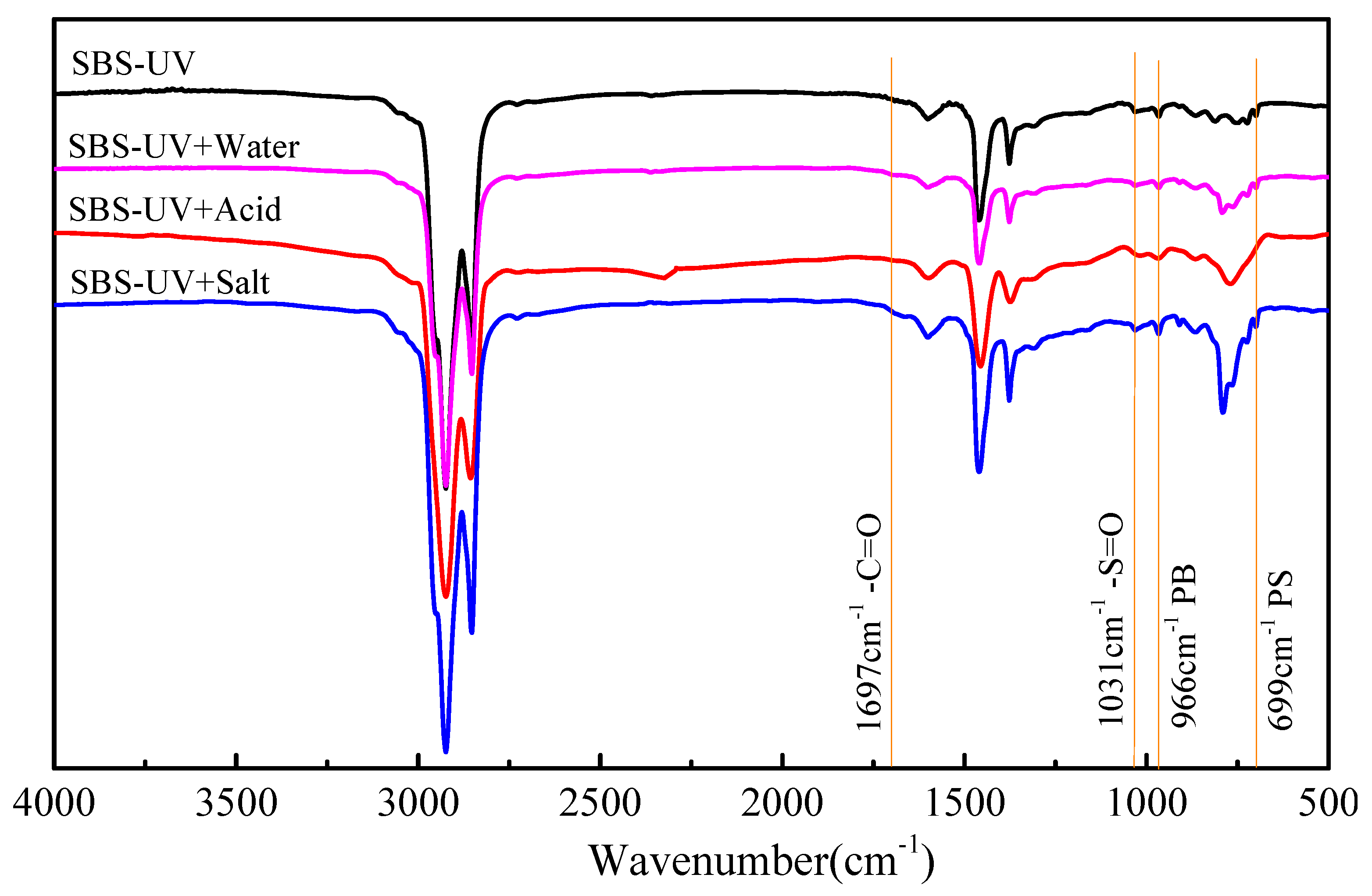
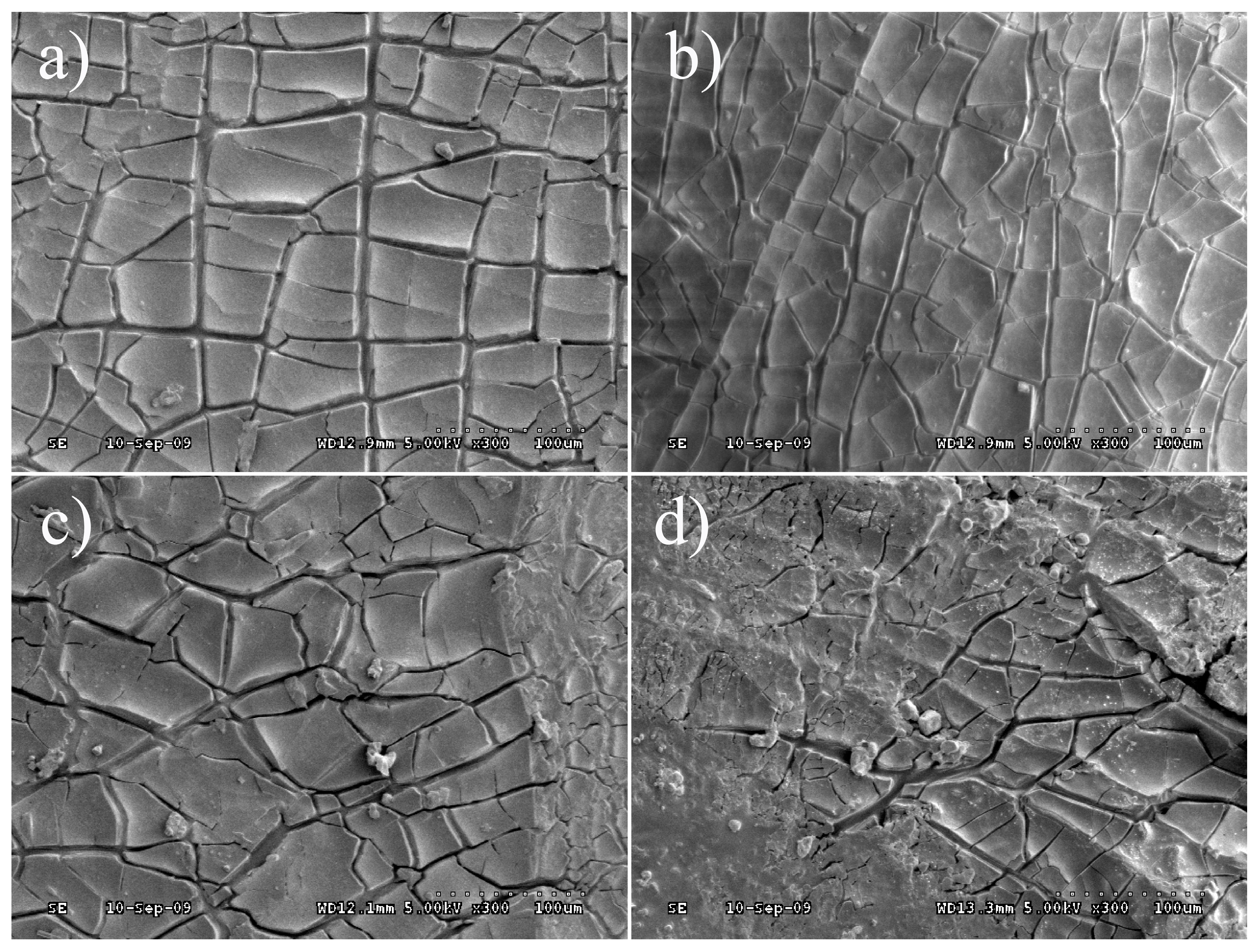
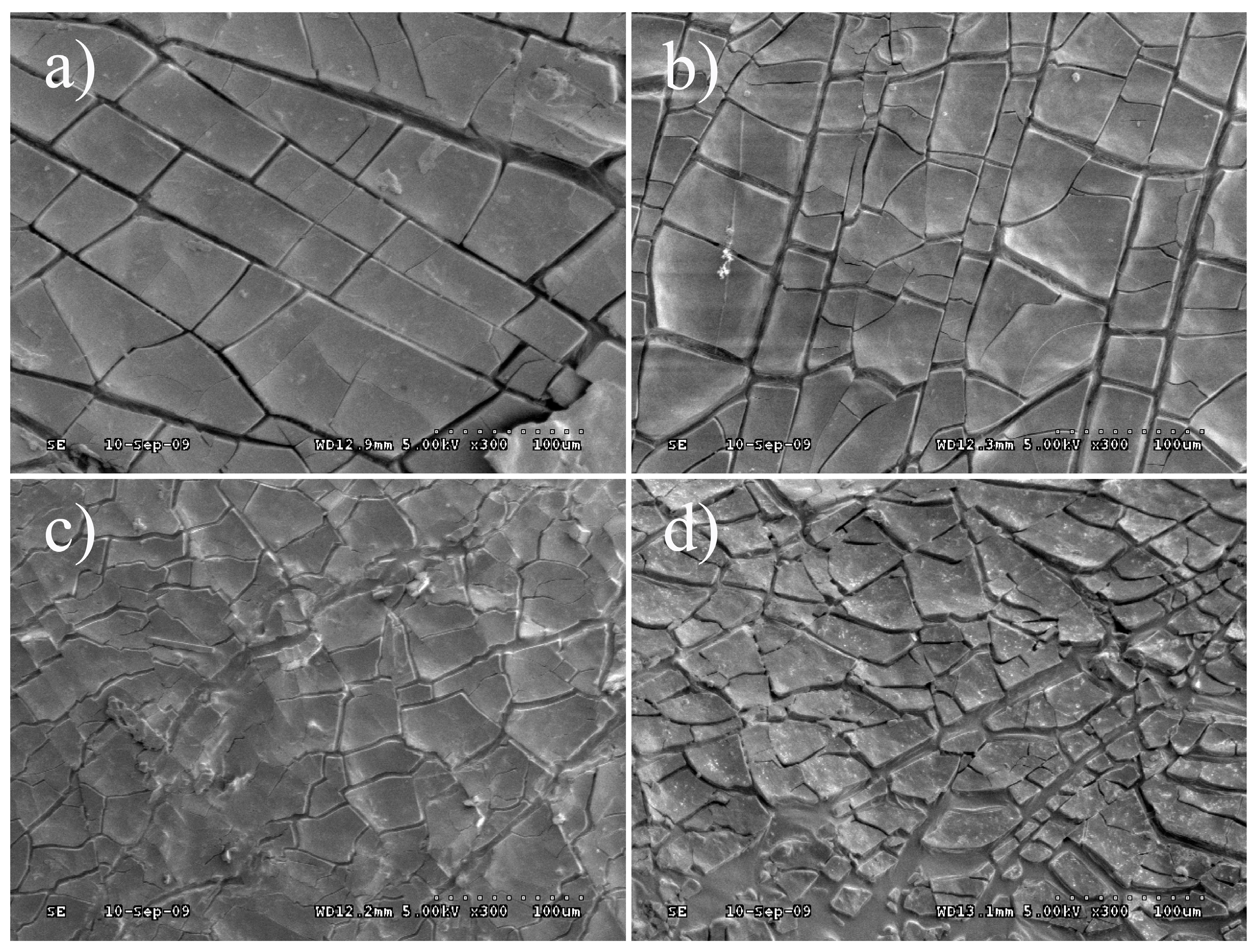
| Properties | Limitation | Values | Methods |
|---|---|---|---|
| Penetration (25 °C, 100 g, 5 g) (0.1 mm) | 60~80 | 61.8 | ASTM D5 |
| Penetration index | −1.5~+1.0 | 0.6 | ASTM D5 |
| Softening point (°C) | ≥46 | 47.8 | ASTM D36 |
| Ductility (15 °C, 5 cm/min) (cm) | ≥100 | >100 | ASTM D113 |
| Density (15 °C) (g/cm3) | — | 1.034 | ASTM D70 |
| Dynamic viscosity (60 °C) (Pa·s) | 180~240 | 215 | ASTM D2171 |
| Modifier | S/B Ratio | Oil Filling Rate (%) | Volatile Component (≤%) | Tensile Strength (≥MPa) | Elongation at Break (≥%) | Tensile Set at Break (≤%) |
|---|---|---|---|---|---|---|
| SBS | 30/70 | 0 | 0.7 | 15 | 700 | 40 |
| Test Index | Bitumen Type | Aging Type | |||||
|---|---|---|---|---|---|---|---|
| Virgin | TFOT | UV | UV + Water | UV + Acid | UV + Salt | ||
| Penetration (25 °C, 0.1 mm) | Virgin bitumen | 61.8 | 43.9 | 36.5 | 33.4 | 31.7 | 30.5 |
| SBS modified bitumen | 65.0 | 56.0 | 47.6 | 43.0 | 42.3 | 42.5 | |
| Softening point (°C) | Virgin bitumen | 47.8 | 53.0 | 54.9 | 55.5 | 57.9 | 56.8 |
| SBS modified bitumen | 69.1 | 71.5 | 73.0 | 74.2 | 76.2 | 75.6 | |
© 2019 by the authors. Licensee MDPI, Basel, Switzerland. This article is an open access article distributed under the terms and conditions of the Creative Commons Attribution (CC BY) license (http://creativecommons.org/licenses/by/4.0/).
Share and Cite
Wei, H.; Bai, X.; Qian, G.; Wang, F.; Li, Z.; Jin, J.; Zhang, Y. Aging Mechanism and Properties of SBS Modified Bitumen under Complex Environmental Conditions. Materials 2019, 12, 1189. https://doi.org/10.3390/ma12071189
Wei H, Bai X, Qian G, Wang F, Li Z, Jin J, Zhang Y. Aging Mechanism and Properties of SBS Modified Bitumen under Complex Environmental Conditions. Materials. 2019; 12(7):1189. https://doi.org/10.3390/ma12071189
Chicago/Turabian StyleWei, Hui, Xianping Bai, Guoping Qian, Feiyue Wang, Zhengfu Li, Jiao Jin, and Yuhao Zhang. 2019. "Aging Mechanism and Properties of SBS Modified Bitumen under Complex Environmental Conditions" Materials 12, no. 7: 1189. https://doi.org/10.3390/ma12071189
APA StyleWei, H., Bai, X., Qian, G., Wang, F., Li, Z., Jin, J., & Zhang, Y. (2019). Aging Mechanism and Properties of SBS Modified Bitumen under Complex Environmental Conditions. Materials, 12(7), 1189. https://doi.org/10.3390/ma12071189






